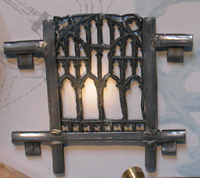 |
 |
 |
 |
 |
 |
 |
|
Fountains Abbey: History
Fountains Abbey: Buildings
|
Mining, quarrying and fuel (28/33)
Fountains engaged in industrial as well as agricultural work, to provide for the community’s needs. Stones for building and roofing had to be quarried and metals mined to produce a number of implements including tools, horseshoes, and piping. The monks required pottery cooking vessels, tiles for roofing and flooring, and fuel to power the forges and for domestic use. The community therefore secured rights to cut turf (turbaries) in the rich peat bogs of Dishforth. In areas where peat was less abundant, restrictions were often imposed to limit how much turf the monks might cut, and when and where they might do so.(126) Fountains’ industrial activity was not simply a matter of self-sufficiency, but of trade and commerce. In the 1360s, lead from the abbey’s mines in Nidderdale was bought for roofing Windsor Castle. The Pipe Rolls of 1363 record that 168 pigs of lead were sent to Windsor via Hull; in 1365 two wagons and ten oxen carried 24 fothers of lead from Coldstones to Boroughbridge, where they were then sent to Windsor by river, via York and London. In the fifteenth century lead from Fountains’ grange at Warsill was sent to York Minster.(127) By the early sixteenth century Fountains’ success in lead trading had come to the attention and concern of the Fellowship of Merchants at York. Fearing for their monopoly, they wrote requesting Abbot Marmaduke Huby to cease business: We understand that you occupy
buying and selling lead and other Huby’s response is, unfortunately, not known, but given that the community continued to trade, he was hardly too bothered by these threats. |
